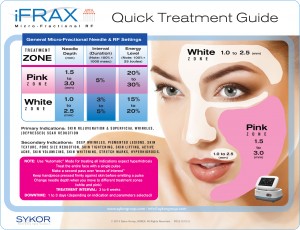How to Perform iFRAX Treatments
After a suitable application of topical anesthetic cream before treatment (generally about 30 to 50 minutes) the face is cleansed and the operator will begin treatment with the iFRAX system. Depending on the desired treatment indication and result the operator will attach the D-Pin tip and begin treating the face in accordance with the treatment guidelines furnished by SYKOR. By adjusting the operating parameters—primarily energy level and the duration of application of the energy, the operator can treat either or both the epidermal and/or dermal skin layers. The topical anesthesia makes treatments comfortable for the patient but allows the operator to use parameter settings which assure treatment efficacy and safety. A single pass is generally sufficient, but frequently the operator will apply a second pass to any “areas of concern” such as scars or areas with visible excess pigmentation. The full face can generally be treated in about twenty minutes.
Step-by-step instructions are as follows:
- General rule for treatments: Always start with a low energy level setting and observe the skin’s response before increasing the energy level.
- On sensitive and thin skin areas (such as lower eyelids if comfortable treating) apply lower parameters with an additional pass if needed rather than higher parameters in a single pass. This recommendation is also applicable to any facial area for new patients.
- On patients with darker skin types, use lower energy settings and shorter duration intervals due to hyper-sensitive melanocytes which may react to the rapid spread of thermal energy and result in PIH, also following the pre-treatment bleaching regimen set forth above.
- It is also recommended to use air cooling (i.e., Zimmer chiller) simultaneously with treatment of dark skin and/or when using higher energy values and longer interval durations.
- Apply the iFRAX Fractional RF handpiece perpendicular to the treated area, ensuring direct and complete skin contact with mild pressure.
- To insert the needles and emit RF energy, pull the finger trigger/switch once for each pulse.
- Move the handpiece to adjacent facial areas with no overlapping of pins. A slight overlapping of the tip’s rim is needed to ensure complete area coverage.
- It may be necessary to change the depth of needle insertion when moving to different facial zones, as indicated on the chart shown above (i.e., “white and pink zones”).
- After applying the tip of the handpiece to the adjacent 10 mm x 10 mm area, once again pull the finger switch to insert the needles and emit the RF energy.
- Treat the entire face—if patient desires complete treatment—with a single pass.
- Make a second pass over apparent “areas of interest” such as scars and visible lesions.
- Treatment of an average-sized face can generally be accomplished in about twenty (20) minutes once the practitioner has achieved a basic familiarity with the device.
- If lower energy and interval settings are used, an additional pass may be necessary to reinforce results. The second pass may be applied in a different direction to the first pass to ensure complete area coverage.
- The endpoint is substantial erythema and edema and visible ablative craters, often accompanied by a tingling heat sensation.
NOTE:
- When treating lower eyelid, pull the skin down away from the eye!
- When treating upper eyelid, avoid the area above the eye ball!
- When treating forehead in close proximity to bone, use milder energy!
iFRAX Clinical Details: Recommended Parameter Settings
Primary Indications: Skin rejuvenation and (depressed) scar reduction
Secondary Indications: Superficial wrinkles, deep wrinkles, pigmented lesions, skin texture, pore size reduction, skin tightening, skin lifting, active acne, skin volume, skin whitening, stretch marks, hyperhidrosis.
- Treat the entire face with a single pulse.
- Make a second pass over “areas of interest.”
- Keep handpiece pressed lightly against skin before emitting a pulse.
- Change needle depth when you move to different treatment zones (white and pink).
- Treatment interval: 3 to 6 weeks.
- Downtime: 1 to 3 days (depending on indication and parameters selected).

